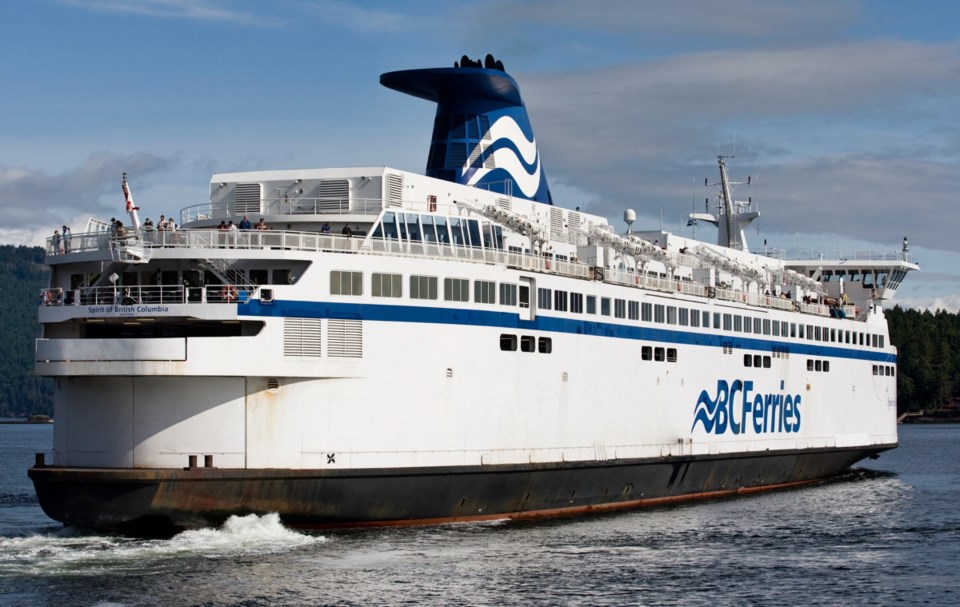 Steady B.C. Ferries fare increases have cost the system 31 million price-shocked passengers who didn’t ride ferries in the past decade because they’re too expensive, a new study commissioned by the Union of B.C. Municipalities says.
Steady B.C. Ferries fare increases have cost the system 31 million price-shocked passengers who didn’t ride ferries in the past decade because they’re too expensive, a new study commissioned by the Union of B.C. Municipalities says.
The paper represents a concerted attempt by the municipal group to urge a rethink of how the system is funded, starting with a freeze on further hikes.
The issue will be further highlighted at the UBCM convention this month in Whistler, where Transportation Minister Todd Stone will hear plenty about the negative effects of high fares.
An afternoon workshop is scheduled where the study will be discussed in detail. And a resolution is circulating that calls on the government to reverse the far-reaching fare hikes and service cuts imposed this year and fund the system as a extension of the highway network.
That would be a major policy shift that would involve pouring millions more in provincial subsidies into the ferry system. The groundwork for the resolution has been laid over the past several months and it will likely pass at the convention. Similar demands have been endorsed by delegates eight times in the last decade, to no effect.
The upcoming one is backed by the new study into the impacts fare hikes are having, done by a consultant retained by some municipal leaders.
It found that passenger volumes have increased in most other transportation modes around B.C., but has dropped 11 per cent on ferries since 2004. (The decline is more pronounced on the smaller and northern routes than on the majors.)
There is strong negative correlation between fare hikes and passenger volume, something the independent ferry commissioner also accepted earlier. The cost of slipping ridership is pegged at $2.3 billion in reduced GDP over the last 10 years.
If fare increases had been held to the inflation rate, the study estimates passenger volumes would have grown 19 per cent. That would have meant 26 million riders in 2013, instead of the actual total of 20 million. The total drop in passengers blamed on off-putting fare increases over 10 years is estimated at 31 million.
Apart from taking a timeout and rethinking the financial basis of the operation, the study also raises the idea of asking the federal government for more money. The federal government subsidy has risen gradually over the years and is now $27 million.
The study calculates that ferries generate enough economic activity to produce $210 million in federal tax revenues. That would be the basis for asking to increase the federal subsidy.
“Since the federal government is a primary beneficiary of a strong and sustainable ferry system, a request to have larger return of those tax revenues invested in the system seems justifiable,” says the study.
By contrast, the provincial government breaks even, with the annual subsidy equalling about what it collects in taxes from economic activity attributed to the ferries.
(That argument inadvertently raises the idea of coastal municipalities subsidizing ferries. If federal and provincial governments derive tax revenue from ferries, then the municipalities would, too, and could be expected to chip in. But that isn’t addressed.)
The new push that started Wednesday is in a completely different direction than the one the government started last year, although they both started from the same point.
That was Ferry Commissioner Gord Macatee’s report in January 2012 calling for a major rethink of the whole system. He said then that “fares have reached the tipping point, imposing a hardship on coastal communities and passengers, and ridership has declined as a result.”
Some of his recommendations to make the ferries sustainable were accepted. But others, such as capping fares, were not. So they are scheduled to continue rising four per cent a year, in concert with this year’s service cuts, which raises the bleak prospect of “the downward trend of reduced ridership, resulting in significant economic impact,” says the UBCM.
The study says B.C. Ferries performs well and its compensation costs are in line. But still, it’s facing a long-term financial crunch.
The government is well into imposing its fix. The UBCM fix is a different approach that would amount to a major course change.



